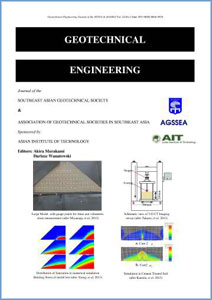Relation between seepage force and velocity of sand particles during sand boiling
Main Article Content
Abstract
Thus far, the focus of studies on seepage failure, known as sand boiling or the piping phenomenon, has been to determine the critical hydraulic gradient or the critical seepage flow velocity. However, the transport of soil after seepage failure also needs to be well investigated in order to estimate the damage to soil structures or the ground. The purpose of this study is to experimentally investigate the relationship between the seepage force and the velocity of the sand particles during sand boiling induced by upward and horizontal seepage flows. In the experiments, silica sand is used as the test material and the migration velocities of the seepage water and the sand particles are calculated from the measured amounts of their discharge. The test results reveal that the equilibrium of the forces exerted on the sand particles, i.e., gravity, buoyancy and fluid-particle interaction, can be successfully used to estimate the velocity of the sand particles subjected to upward seepage flow and that the seepage force needed for the horizontal transport of the sand tends to decrease as the velocity of the sand particles increases.
Article Details

This work is licensed under a Creative Commons Attribution-NonCommercial-NoDerivatives 4.0 International License.
Copyright © 2019 Association of Geotechnical Societies in Southeast Asia (AGSSEA) - Southeast Asian Geotechnical Society (SEAGS).


